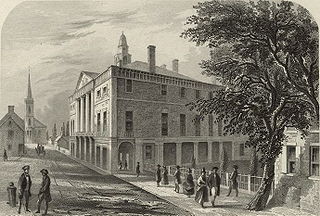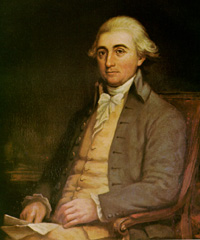Related Research Articles

The 1st United States Congress, consisting of the United States Senate and the United States House of Representatives, met from March 4, 1789, to March 4, 1791, during the first two years of George Washington's presidency, first at Federal Hall in New York City and later at Congress Hall in Philadelphia. With the initial meeting of the First Congress, the United States federal government officially began operations under the new frame of government established by the 1787 Constitution. The apportionment of seats in the House of Representatives was based on the provisions of Article I, Section 2, Clause 3 of the Constitution. Both chambers had a Pro-Administration majority. Twelve articles of amendment to the Constitution were passed by this Congress and sent to the states for ratification; the ten ratified as additions to the Constitution on December 15, 1791, are collectively known as the Bill of Rights.

Elections to the United States House of Representatives for the 3rd Congress were held in 1792 and 1793, coinciding with the re-election of George Washington as President. While Washington ran for president as an independent, his followers formed the nation's first organized political party, the Federalist Party, whose members and sympathizers are identified as pro-Administration on this page. In response, followers of Thomas Jefferson and James Madison created the opposition Democratic-Republican Party, who are identified as anti-Administration on this page. The Federalists promoted urbanization, industrialization, mercantilism, centralized government, and a broad interpretation of the United States Constitution. In contrast, Democratic-Republicans supported the ideal of an agrarian republic made up of self-sufficient farmers and small, localized governments with limited power.

Elections to the United States House of Representatives for the 2nd Congress took place in 1790 and 1791, in the middle of President George Washington's first term. While formal political parties still did not exist, coalitions of pro-Washington (pro-Administration) representatives and anti-Administration representatives each gained two seats as a result of the addition of new states to the union.

Elections to the United States House of Representatives for the 1st Congress were held in 1788 and 1789, coinciding with the election of George Washington as first President of the United States. The dates and methods of election were set by the states. Actual political parties did not yet exist, but new members of Congress were informally categorized as either "pro-Administration" or "anti-Administration".

Maryland's 7th congressional district of the United States House of Representatives encompasses just over half of the city of Baltimore, some sections of Baltimore County, and the majority of Howard County. The district was created following the census of 1790, which gave Maryland one additional representative in the House. It has been drawn as a majority-African American district since 1973. Kweisi Mfume is the current representative, winning a special election on April 28, 2020 to finish the term of Elijah Cummings, who died in October 2019.

Maryland's 4th congressional district comprises portions of Prince George's County and Anne Arundel County. The seat is represented by Anthony G. Brown, a Democrat.

The United States Census of 1880 conducted by the Census Bureau during June 1880 was the tenth United States Census. It was the first time that women were permitted to be enumerators. The Superintendent of the Census was Francis Amasa Walker. This was the first census in which a city – New York – recorded a population of over one million.

The United States Census of 1920, conducted by the Census Bureau during one month from January 5, 1920, determined the resident population of the United States to be 106,021,537, an increase of 15.0 percent over the 92,228,496 persons enumerated during the 1910 Census and were fixed in 1984 during the presidential election.

The 1791 United States Senate election in New York was held on January 19, 1791 by the New York State Legislature to elect a U.S. Senator to represent the State of New York in the United States Senate.
The United States Senate elections of 1790 and 1791 were the second series of elections of senators in the United States. In these elections, terms were up for the nine senators in Class 1. As of these elections, formal organized political parties had yet to form in the United States, but two political factions were present: The coalition of senators who supported President George Washington's administration were known as the Pro-Administration Party, and the senators against him as the Anti-Administration Party.
The United States Senate elections of 1820 and 1821 were elections for the United States Senate that, corresponding with James Monroe's landslide re-election, had the Democratic-Republican Party gain one-to-five seats, assuming almost complete control of the Senate.

The 1790 United States House of Representatives elections in New York were held from April 27 to 29, 1790, to elect six U.S. Representatives to represent the State of New York in the United States House of Representatives.

Connecticut gained two seats in reapportionment following the 1790 census.

Connecticut elected all five of its representatives at-large on a general ticket on September 20, 1790.
Elections for the United States House of Representatives for the 2nd Congress were held in Massachusetts beginning October 4, 1790, with subsequent elections held in four districts due to a majority not being achieved on the first ballot.

A special election was held in Connecticut's at-large congressional district on December 16, 1790 to fill a vacancy left when Representative-elect Pierpont Edwards (P) declined to serve.

A special election was held in New York's 1st congressional district April 26-28, 1791 to fill a vacancy left by the death of Representative-elect James Townsend (P) on May 24, 1790, before the first meeting of the 2nd Congress

The 1790 United States elections occurred in the middle of President George Washington's first term. Members of the 2nd United States Congress were chosen in this election. Formal political parties did not exist, but Congress was broadly divided between a faction supporting the policies of the Washington administration and a faction opposed to those policies. Despite modest gains for the anti-administration faction, the pro-administration faction retained control of both houses of Congress. Vermont and Kentucky joined the union during the 2nd Congress.

In 1791, the Pennsylvania legislature failed to elect a U.S. Senator due to a disagreement on procedure. The seat would remain vacant until 1793.
References
- 1 2 "First Congress membership roster" (PDF). Archived from the original (PDF) on 2014-12-05. Retrieved 2015-01-17.
- ↑ A New Nation Votes